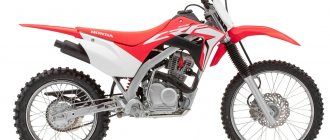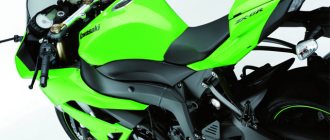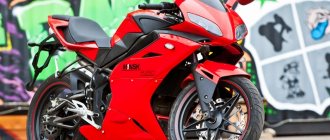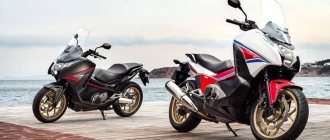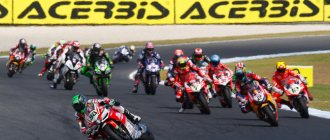| Suzuki DR 125 SE (1994-2002) |
Model of the budget enduro motorcycle Suzuki DR 125
Its history begins in 1982 - it was at that time that the motorcycle was first introduced to the market under the name
Suzuki DR125S
.
The model positions itself as a simple, cheap off-road motorcycle for beginners, with a simple air engine, suspension and chassis. In Russia, the old generations of Suzuki DR 125 S are practically not represented, and only models of the 90s Suzuki DR125SE
, so in this review we will consider them. By the way, the older versions of the motorcycle differ only in appearance, but technically they are practically the same motorcycle.
Main modifications of Suzuki DR 125:
- Suzuki DR 125 S
- the version produced before 1994 is distinguished by the presence of a kick starter. - Suzuki DR 125 SE
- version produced since 1994, is distinguished by the presence of an electric starter. More popular in Russia.
A special feature of the Suzuki DR 125 is a 1-cylinder, 4-stroke, air-cooled engine with a capacity of 124 cc and producing 12 hp. power and almost 10 Nm of torque. The engine has 2 valves and 1 camshaft.
Other features of the motorcycle include simple suspension (conventional telescopic forks at the front and a monoshock at the rear), a 6-speed gearbox, a rear drum brake and a dry weight of 114 kg.
The Suzuki DR 125 SE model was produced until 2002, after which it was discontinued. In 2008, Suzuki decided to resurrect the model by launching a budget motard - Suzuki DR 125 SM, which has the same engine, but with an injection power system instead of a carburetor.
The main competitors of the Suzuki DR 125 in the class:
- Honda XR125L
- Kawasaki KLX 125
Brief history of the model
- 1982 - start of production and sale of the Suzuki DR 125 S series of motorcycles.
- 1994 - the appearance of the Suzuki DR 125 SE modification, the main difference is the electric starter.
Model:
Suzuki DR125SE.
Factory designation:
DR125SER.
- 1995 - Model:
Suzuki DR125SE.
Factory designation:
DR125SES. - 1996 - Model:
Suzuki DR125SE.
Factory designation:
DR125SET. - 1997 - Model:
Suzuki DR125SE.
Factory designation:
DR125SEV, DR125SEUV. - 1998 - Model:
Suzuki DR125SE.
Factory designation:
DR125SEW, DR125SEUW. - 1999 - Model:
Suzuki DR125SE.
Factory designation:
DR125SEX, DR125SEUX. - 2000 - Model:
Suzuki DR125SE.
Factory designation:
DR125SEY, DR125SEUY. - 2001 - Model:
Suzuki DR125SE.
Factory designation:
DR125SEK1, DR125SEUK1. - 2002 - Model:
Suzuki DR125SE.
Factory designation:
DR125SEK2, DR125SEUK2.
SUZUKI DR650S
The Suzuki DR650S is arguably the best all-round dual-purpose motorcycle available today. Each DR650S is quality built by Suzuki and is powered by a reliable 644cc four-stroke single engine. Oil-cooled on a durable steel semi-double frame. Telescopic forks and link-type rear suspension allow you to overcome difficult trails or city roads. So this motorcycle can be enjoyed by a variety of riders, the seat height can be reduced significantly. Durable aluminum spoked wheels, carrying tires that can handle the road or mud, are mounted to allow riders to tackle pavement or trails with ease. Featuring a new solid gray iron body with distinctive red, blue and black graphics, the DR650S looks good on any surface.
- Ready to cruise around town, down the highway, or along your favorite trail
- Reliable, four-stroke, 644 cc. CM air and oil cooled
- Smooth shifting gearbox with light clutch
- Convenient push-button electric starter
- Optional adjustable seat height
Specifications
Technical characteristics of Suzuki DR 125:
| Model | Suzuki DR 125 SE |
| Motorcycle type | enduro |
| Year of issue | 1994-2002 |
| engine's type | 1-cylinder, 4-stroke |
| Working volume | 124 cm³ |
| Cooling | air |
| Bore/Stroke | 57 x 48.8 mm |
| Compression ratio | 9,5:1 |
| Number of valves per cylinder | SOHC, 2 valves per cylinder |
| Fuel supply system | carburetor, 1x MIKUNI BST31 CV |
| Ignition type | electronic (CDI) |
| Maximum power | 12 hp at 9500 rpm |
| Maximum torque | 10 Nm at 8600 rpm |
| Clutch | Multi-disc in oil bath, cable drive |
| Transmission | 6-speed |
| type of drive | chain |
| Frame | steel |
| Front suspension | telescopic fork 35 mm, travel - 205 mm |
| Rear suspension | pendulum with monoshock absorber, stroke - 200 mm |
| Front tire size | 70/100–21 or 80/80–21 |
| Rear tire size | 90/90-18 |
| Front brakes | 1 disc, 230 mm, 1-piston caliper |
| Rear brakes | drum |
| Motorcycle length | 2110 mm |
| Motorcycle width | 805 mm |
| Motorcycle height | 1170 mm |
| Seat height | 800 mm |
| Wheelbase | 1385 mm |
| Minimum ground clearance (clearance) | 240 mm |
| Gas tank capacity | 13 l (reserve - 2.5 l) |
| Maximum speed | 110 km/h |
| Motorcycle weight | 114 kg - dry 127 kg - loaded |
Three "firsts"
These motorcycles are not intimidating with the enormous power of their engines, but they also do not require frequent maintenance. They don't boast high-strength, high-tech suspension components and don't handle as sharply as more modern models, but they cost much less. For serious competition, they do not have very high ground clearance, but at the same time, the seat height is much lower than that of sports models. By today's standards they can be considered slightly outdated. But they are quite suitable for a first acquaintance with the world of enduro. Meet the Yamaha TT-R 250, Suzuki DR-Z 250 and Kawasaki KLX 250.
The acquaintance with this trio began with an activity called Hill climbing - climbing a hill. The short slope with ruts, holes and in places dug up loose soil was conquered without much difficulty even by me, riding a KLX with its semi-road or, rather, semi-off-road tires. Where the slope was mostly flat, it was possible to safely drive smoothly in second or third gear. It was necessary to resort to turning on the short first one very rarely - it is useful only when starting from a standstill on a very steep climb. And the fact that the KLX engine is the weakest in terms of maximum power is compensated by smooth traction from the very bottom without the pick-up at the top that is characteristic of the same TT-R 250. This makes him the friendliest of the three.
Suzuki DR-Z 250 249 cm3 n.a. 1 cylinder 115 kg $5500
While the Yamaha TT-R 250 and Suzuki DR-Z 250 are 80% off-road and 20% on-road, Kawasaki is 50/50. This is evidenced not only by the all-mountain tires, but also by a fully functional dashboard, a small metal trunk, and the absence of the kick starter hole found on the other two bikes. In addition, the KLX 250 is the only bike of this trio equipped with a liquid cooling system. Everything tells us that the motorcycle was in the wrong place at the wrong time (read: test). That is why it would not be entirely correct to compare it as an equal with the other two motorcycles. It is a different, not bad at all, universal motorcycle. The ease with which he conquered steep climbs and paths is a credit to him. Just don’t overestimate its capabilities and rush into the windfall - it’s not designed for that.
In our test, the Kawasaki KLX 250 lagged behind also because of the all-purpose tires installed on it. If it had been replaced with an off-road one, he could have shown better results. Even though it lags behind in terms of engine power, it is at a high level in terms of controllability due to the “front end” design being different from others. After all, it is the only one equipped with an inverted fork, while the competitors in the test have conventional forks that are not distinguished by high bending and torsional rigidity. That is why the KLX is more informative when steering, and allows you to accurately follow the trajectory even when the front wheel drifts.
Therefore, it is more friendly for beginners who have not ridden enduro at all. For them, KLX will be the best option of this trinity. Those who have at least a little experience, or for whom “250s” are the next stage of development after “125s” (or less cubic capacity equipment), should not opt for it.
Suzuki DR-Z 250 is noticeably more powerful and more suitable for complete off-road use. But to realize all the possibilities inherent in it, certain skills are required. Its reactions to movements with the throttle handle are sharper. Although this is not only due to the more powerful engine. Unlike the Kawasaki, the off-road rear tire grips the ground better, which minimizes drive wheel idling and allows the bike to climb onto the rear wheel more easily.
The chassis seems more compact and cohesive - this is probably due to the rigid frame that was once inherited from the RM-Z motocross bike. This is also where the geometry of the steering column comes from. All this gives the DR-Z 250 excellent handling and feedback from the road. The pilot feels everything that is happening under the wheels of the bike and can react in time to drift or wheel slip.
Kawasaki KLX 250 249 cm3 24 hp 1 cylinder 119 kg $5500
In terms of handling, this motorcycle is the most stable of the three thanks to a moderately stiff suspension, which efficiently handles both small and large irregularities. Because of this, the wheels are almost constantly in engagement with the ground or other surfaces, obstacles that may be encountered along the way. It has the same suspension travel as the Yamaha TT-R 250, but only on the DR-Z can it be used to the maximum during everyday, not very aggressive driving.
Suzuki's gearbox also deserves praise. Of the three, she is the clearest. On the same Kawasaki KLX 250, when driving up a steep slope, the second gear slipped out more than once when I accidentally lightly pressed the gearshift lever. The Yamaha TT-R 250, on the contrary, has a gearbox that is too rigid, and therefore there were problems.
The TT-R 250 made you feel from the very first meters that it was not like the others. Its engine is tuned for maximum performance at the top, and therefore low speeds were sacrificed - it practically does not pull at them. To achieve sharp acceleration, this engine must be constantly cranked, and riding under tension, as can be done on the other two bikes, is no longer fun. But that's the whole thrill of driving the TT-R. It allows you to feel like a pilot of not just an enduro, but a sports enduro. But at the same time, it makes the inexperienced pilot feel that he has not yet “grown up.” The behavior of the TT-R can frighten a beginner, and sometimes even play a cruel joke on him.
The motorcycle reacts to steering movements much more sharply than others. The chassis is just as well-built as the DR-Z, but the suspension settings are firmer from stock. On the TT-R 250, I often found myself flying through a series of bumps or going over them in a corner with constant sideways drift on both wheels. These same sections were driven on the DR-Z much more stable and without the extreme sensations that the TT-R 250 gives with enviable consistency.
Yamaha TT-R 250 249 cm3 28 hp 1 cylinder 120 kg $4900
But the hard suspension settings of the TT-R 250 will appeal to those who like to jump over rocks, jump off trampolines, climb over logs and other obstacles. In such situations, they provide maximum ground clearance, which allows the motorcycle to sit on its “belly” less often. And in general, the Yamaha is the toughest motorcycle in every sense, and therefore will be a good choice for those who soon want to switch to a cross-country bike. This motorcycle is the least inclined to forgive the pilot’s mistakes, and therefore it is better not to ride it without prior preparation. In addition, the TT-R requires more time to get used to the driving style typical of cross-country racers.
Verdict: The Yamaha TT-R 250 and Suzuki DR-Z 250 are quite capable of going where modern sports 250s can go. Perhaps not so quickly and confidently. A Kawasaki KLX 250 is suitable for those who will spend more time on the pavement rather than off it.
Text: Vladislav Sofonov
SUZUKI DR-Z125
2020 Suzuki DR-Z 125 model year.
Here comes the DR-Z125L to make sure young short riders can handle the mud. Large 19-inch front and 16-inch rear tires and a front disc brake provide excellent performance for a size-appropriate motorcycle. Designed to mirror Suzuki's championship-winning RM-Z and RMX models.
This DR-Z delivers a more race-ready look, while sharp handling and strong low- and mid-range power deliver the dynamics that define off-road bikes. The looks show that you can't judge a book by its cover, because the DR-Z125L is an unassuming package packed with plenty of fun.
SUZUKI DR-Z50
2020 Suzuki DR-Z 50 model year.
The 2019 Suzuki DR-Z50 is the perfect way to introduce young aspiring riders to the sport of motorcycles. This compact mini bike from Suzuki offers ease and convenience for riders who are just getting started on two wheels. Featuring an automatic clutch, three-speed transmission, electric start and a low 22-inch seat, this race bike will help build confidence and improve riding skills for young, controlled riders. 49 cc engine The CM provides a smooth, controlled power range, and adult leaders can adjust its power level so young riders can learn at the right pace. This bike can stay in the family for years thanks to its rugged construction and durable 10-inch wheels; The Suzuki DR-Z50 combines a reliable engine with a high-quality chassis designed to last a long time. The 2019 DR-Z '50 is the perfect way to get your whole family involved in motorcycle riding!
